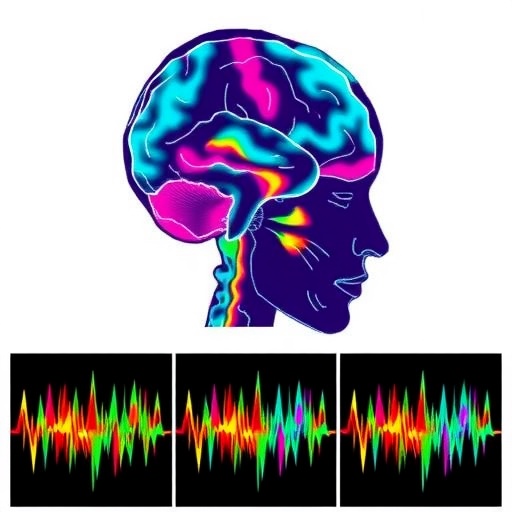In an age where neonatal care continually seeks to embrace both cutting-edge technology and tactile, comforting interventions, a recent study reveals fascinating insights into how auditory stimuli might influence the physiology of preterm infants. This groundbreaking research, conducted by Kaur, Bailey, Schneider, and colleagues, intricately dissects the effects of recorded maternal heartbeat and voice sounds on the resting energy expenditure (REE) of premature babies, opening a portal into the subtle interplay between sensory input and metabolic regulation in this vulnerable population.
Preterm infants generally endure a host of physiological challenges, with their immature systems often struggling to maintain homeostasis. Among key parameters influencing their growth trajectory and overall survival, resting energy expenditure is crucial, as it represents the baseline metabolic demand necessary to support vital bodily functions. Any factor that can modulate REE without compromising stability could potentially enhance neonatal outcomes. The study’s premise builds upon the profound biological significance of the maternal heartbeat and voice—sensory cues naturally absorbed in utero—postulating that replicating these auditory environments ex utero may beneficially influence infant metabolism.
Employing a prospective randomized crossover design, the investigators enrolled premature neonates and exposed them alternately to a recorded maternal heartbeat and voice (MHV) condition and a control environment characterized by ambient noise. This innovative approach enabled each infant to serve as their own control, effectively minimizing intersubject variability that often complicates neonatal studies. The methodology ensured that any observed effects could be ascribed with higher confidence to the auditory stimuli rather than confounding factors.
Resting energy expenditure was measured during both conditions utilizing indirect calorimetry, a non-invasive, gold-standard technique to assess oxygen consumption and carbon dioxide production and to calculate metabolic rate. This precise measurement allowed the researchers to capture nuanced fluctuations in metabolic demand in response to auditory inputs. Intriguingly, the findings revealed a statistically significant reduction in REE during periods when infants were exposed to recorded maternal heartbeat and voice compared to ambient noise. This suggests that such auditory interventions provide a calming, stabilizing effect that reduces the metabolic burden placed on these infants.
Delving deeper, the data propose a biobehavioral mechanism wherein maternal auditory cues act to simulate the in utero sensory environment, thereby attenuating stress responses that would otherwise elevate metabolic rate. Stress and discomfort in preterm infants can precipitate tachycardia, increased respiratory effort, and heightened energy expenditure, all detrimental to growth and development. By mitigating these stressors through familiar, biologically meaningful sounds, the study underscores a promising avenue for enhancing energy conservation and promoting growth in NICU settings.
Moreover, the study’s crossover design further confirms the reproducibility and consistency of these effects. Each infant demonstrated lower REE during exposure to their mother’s heartbeat and voice recordings regardless of the sequence, emphasizing the robustness of the intervention. This provides compelling evidence that auditory-based environmental modifications are not merely incidental but inherent modulators of neonatal metabolic physiology.
The implications of these findings extend well beyond the realm of neonatal intensive care. The demonstration that maternal auditory stimuli can influence fundamental metabolic processes invites reconsideration of the sensory environments provided in hospitals worldwide. Infant incubators and NICUs often expose babies to unpredictable, sometimes noxious, auditory disturbances. Integrating controlled, biologically relevant sounds may usher in an era of sensory-tailored therapeutic strategies that optimize outcomes for preterm populations.
On a translational level, this research encourages development of individualized neonatal auditory therapy programs. Digital recordings of maternal heartbeat and voice, easily integrated into incubator sound systems, could become standard components of care protocols. Such low-cost, low-risk interventions align well with the increasing emphasis on non-pharmacological therapies that harness natural stimuli to support infant development.
Nonetheless, the study also hints at areas ripe for further exploration. Given that metabolic rate is only one pillar of neonatal physiology, future research could investigate whether these auditory interventions impact other critical parameters such as neurodevelopmental trajectories, inflammatory markers, or autonomic regulation. Longitudinal follow-up studies would be invaluable in determining if early exposure to maternal sounds influences long-term growth and cognitive outcomes.
Additionally, variations in the characteristics of maternal auditory signals—such as rhythm, pitch, volume, and duration—remain largely uncharted territory. Understanding how these features modulate infant responses could allow for fine-tuning of therapeutic soundscapes tailored to individual needs. Moreover, exploring interactions with other sensory modalities, including tactile and olfactory cues, could broaden the scope of sensory-based neonatal interventions.
While the current investigation elegantly demonstrates metabolic benefits in a controlled environment, real-world implementation must consider logistical challenges. Ensuring consistent, high-fidelity audio playback, preventing overstimulation, and integrating parent involvement remain critical practical aspects. Education for neonatal care personnel on the significance and application of maternal auditory cues could accelerate adoption and maximize impact.
This study also reinforces a fundamental biological truth: the innate connection between mother and infant extends beyond biochemical bonds to encompass sensory and metabolic synchrony. The maternal heartbeat and voice symbolize the in utero lifeline—a rhythmic, familiar presence that, even after premature birth, continues to provide vital support. Harnessing this connection transforms a natural maternal-infant bond into a potent clinical tool, blending empathy and science into neonatal care.
In the context of neonatal research, this study represents a sophisticated leap forward by combining rigorous experimental design with a nuanced understanding of human development. It exemplifies how non-invasive, environment-based interventions can influence core physiological processes, expanding our arsenal beyond traditional medical approaches centered on pharmaceuticals and mechanical support.
Moreover, as survival rates for preterm infants improve globally, attention increasingly shifts from mere survival to quality of life and neurodevelopmental integrity. Interventions like auditory maternal cues that reduce energy expenditure might help preterms allocate metabolic resources to brain growth and repair, potentially reducing the incidence or severity of complications associated with prematurity.
Interestingly, while the study specifically examines recorded maternal heartbeat and voice, the broader principle may inspire creative adaptations. Could father’s voice or sibling sounds also exert beneficial effects? What about synthetic sounds designed around maternal acoustic patterns? These speculative avenues beckon further inquiry while rooted in the proven biological responsiveness illuminated here.
Ultimately, this research stands as a testament to the profound role of sensory experience in shaping human physiology from the earliest moments of life. It propels neonatal care toward a future where technology is harnessed not only to sustain life but to replicate, preserve, and amplify the comforting rhythms of maternal presence that nurture growth and survival.
As this field evolves, integration of auditory interventions with advances in wearable monitoring, machine learning for personalized therapy, and family-centered care models could transform outcomes for preterm infants worldwide. The maternal heartbeat and voice, once ephemeral prenatal companions, may become engineered lifelines for the tiniest patients, marrying scientific insight with the timeless power of a mother’s touch—audible and enduring.
Subject of Research: Resting energy expenditure regulation by maternal heartbeat and voice sounds in premature infants.
Article Title: A prospective randomized crossover trial studying the effects of maternal heartbeat and voice sounds on resting energy expenditure in preterm infants.
Article References:
Kaur, G., Bailey, S.M., Schneider, S. et al. A prospective randomized crossover trial studying the effects of maternal heartbeat and voice sounds on resting energy expenditure in preterm infants. J Perinatol (2025). https://doi.org/10.1038/s41372-025-02453-4
Image Credits: AI Generated
DOI: https://doi.org/10.1038/s41372-025-02453-4
Tags: auditory environments for neonatal outcomesenhancing neonatal growth trajectorymaternal heartbeat effects on infantsmaternal sounds influence preterm infantsmaternal voice impact on metabolismmetabolic regulation in premature infantsneonatal care auditory stimuliphysiological challenges preterm infantsrandomized crossover design studyresting energy expenditure preterm babiessensory input preterm infant healthvoice stimuli in neonatal care





